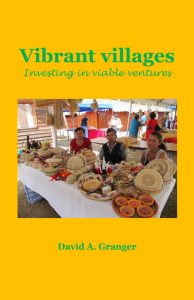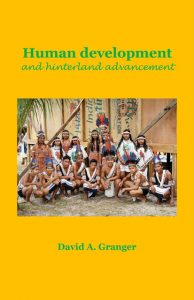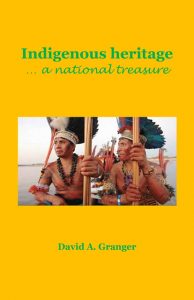A REVIEW of four books by David Granger ? Guyana’s Indigenous people: identity, inclusivity and prosperity; Human development and hinterland advancement; Indigenous heritage is a national treasure; and, Vibrant villages…viable ventures.
David Granger is a man on a mission. He believes strongly in equality and has set himself the ambitious task of narrowing inequalities between his country’s hinterland and coastland.
 The Rupununi, correctly called the Upper Takutu-Upper Essequibo Region, is Guyana’s largest region. It encompasses an area which is larger than Costa Rica. The Barima-Waini, Cuyuni-Mazaruni, Potaro-Siparuni, also, are large regions which are populated primarily by indigenous peoples. There are significant, widely-scattered communities in the Pomeroon-Supenaam, Demerara-Mahaica; Mahaica-Berbice, East Berbice-Corentyne and Upper Demerara-Berbice Regions. Guyana’s nine recognised indigenous groups – Akawaio, Arawak, Arecuna, Carib, Makushi, Patamona, Wai-Wai, Wapishana and Warrau – live in the hinterland, for the most part.
The Rupununi, correctly called the Upper Takutu-Upper Essequibo Region, is Guyana’s largest region. It encompasses an area which is larger than Costa Rica. The Barima-Waini, Cuyuni-Mazaruni, Potaro-Siparuni, also, are large regions which are populated primarily by indigenous peoples. There are significant, widely-scattered communities in the Pomeroon-Supenaam, Demerara-Mahaica; Mahaica-Berbice, East Berbice-Corentyne and Upper Demerara-Berbice Regions. Guyana’s nine recognised indigenous groups – Akawaio, Arawak, Arecuna, Carib, Makushi, Patamona, Wai-Wai, Wapishana and Warrau – live in the hinterland, for the most part.
David Granger travelled by air, all-terrain vehicle, river-boat and on foot through these vast regions, visiting dozens of indigenous villages during all three of his presidential campaigns for the General and Regional Elections in 2011, 2015 and 2020 and during his tenure as President from 2015.
He assembled a six-party Coalition – comprising A Partnership for National Unity and the Alliance For Change (APNU+AFC) – but did not win some of the communities in those elections. Campaigning there, however, allowed him to experience, first-hand, the situation of the indigenous peoples. That experience confirmed the President’s long-held assessment of the inequalities between coastland and the hinterland communities and the need for him to solve the problems of development.
 What David Granger saw and felt during that campaign, drove him to place indigenous development as one of his Administration’s foremost priorities. He has never deviated or wavered from this mission.
What David Granger saw and felt during that campaign, drove him to place indigenous development as one of his Administration’s foremost priorities. He has never deviated or wavered from this mission.
‘Guyana’s indigenous people: Identity, inclusivity and prosperity’ constitutes the text of his maiden address to the National Toshaos’ Conference (NTC) on the 28th August 2015. It lays out the President’s five-year, ten-point Plan of Action for Hinterland Development aimed at “eradicating extreme poverty, reducing youth unemployment and increasing prosperity”.
It was not surprising the indigenous leaders adopted the inspiring plan for hinterland and indigenous peoples’ development immediately. Plans, however, are only as efficacious to the extent that they are implemented. Progress, in the Plan’s implementation proved slothful. The President was not discouraged. One year later, he proposed the establishment a National Indigenous Peoples’ Authority (NIPA) to ensure the implementation of the decisions emerging from the annual conferences of the country’s indigenous leaders.
This proposal did not gain traction but this did not diminish the President’s commitment to indigenous peoples’ development. Two years after his NIPA proposal, the President sought to highlight provisions of the Amerindian Act which empower indigenous peoples’ development. Addressing the annual National Toshaos’ Conference 2018, the President reminded indigenous leaders that the ‘Act’ mandates them to prepare strategies and plans for reducing poverty, improving access to health and education and the sustainable management of natural resources.”
The President saw the Act as an instrument of empowerment, particularly when it comes to their villages. He reminded them that he had called for village improvement plans. The text of the President’s address forms the content of the second book: ‘Vibrant villages… viable ventures’.
The President addressed the National Toshaos’ Conference again one year later in 2019. His address constitutes the text of the third book, ‘Human development and hinterland advancement’.
The President used this occasion to present an impressive report card of his Administration’s efforts at promoting hinterland development. He noted the improvements which were made in education, health, job-creation and social protection. He explained what hinterland residents could look forward to during the Decade of Development 2020-2029 and situated these forward-looking plans within the framework of the Sustainable Development Goals.
 The President was keen to point out that, despite the Administration’s achievements, serious social challenges remained to be overcome. He left little doubt about his Administration’s commitment to working with indigenous leaders to achieve this objective.
The President was keen to point out that, despite the Administration’s achievements, serious social challenges remained to be overcome. He left little doubt about his Administration’s commitment to working with indigenous leaders to achieve this objective.
‘Indigenous heritage is a national treasure’ reproduces the texts of addresses the President gave at Indigenous Heritage Day observances at Pakuri Village and at St. Cuthbert’s Mission Heritage Village in September 2016 and September 2017, respectively. The village was presented as the epicentre of cultural development in this book. The President returned to the theme of inequality in the first address at St. Cuthbert’s Village. He argued that education was the surest way to reduce inequality. The address highlighted how his Administration had improved hinterland education access, expanded public services and ensured greater protection for indigenous peoples.
At Pakuri Village, he described the village as the custodian of the customs of the people. He argues for greater engagement of villages in education, job-creation, environmental protection and the strengthening of the economy. There is profound message which was being transmitted and indicated that the celebration of ‘Indigenous Heritage Month’ would become more meaningful were there to be tangible gains in human development within these villages.
David Granger has stayed the course. He has remained true to his word to improve indigenous and hinterland development. This four-book collection is a chronicle of President Granger’s efforts to improve hinterland development and to foster indigenous human development. It is a portrait of persistence.
His is a hard act to follow. No other President has placed as much emphasis on this area of national development. Unlike so many of his predecessors who have viewed the indigenous communities as potential political constituencies, David Granger sees these communities as being potential economic powerhouses capable of providing adequately for their residents.
The four-book collection is a mini-dossier of an enlightened statesman who appreciates that attending to the poorest and most deprived sections of the population is both a governmental obligation and an economic necessity for authentic human development. The special value of this collection is the practical solutions it provides as to how Indigenous peoples can advance their own development and how the state can best support these efforts.



.jpg)









